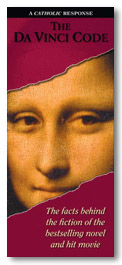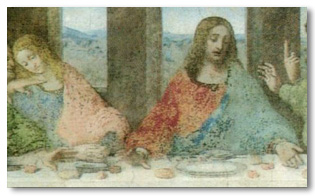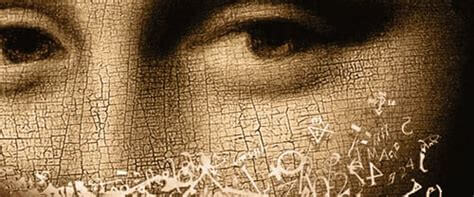 AMY WELBORN
AMY WELBORNAmy Welborn points out some of the many errors about religion, history, and art contained in The Da Vinci Code.
 |
What is The Da Vinci Code?
The Da Vinci Code is a novel by Dan Brown that has held one of the top two or three places on best-seller lists since early summer. More than 3 million copies (ed: now over 40 million) are in print.
In Brown’s novel, the “Da Vinci code” refers to cryptic messages supposedly incorporated by Leonardo Da Vinci into his artwork. According to the novel, Leonardo was a member of an ancient secret society called the “Priory of Sion” dedicated to preserving the “truths” that Jesus designated Mary Magdalene as His successor, that His message was about the celebration of the “sacred feminine,” that Jesus and Mary Magdalene were married and had children and that the Holy Grail of legend and lore is really Mary Magdalene, the “sacred feminine,” the vessel who carried Jesus’ children.
Sounds like an intriguing bit of lost history. Is it? Long story short: No.
Is the Holy Grail really the “sacred feminine?”
The legend of the Holy Grail has taken many forms throughout history, but it has always identified the Grail as the cup Jesus used at the Last Supper. The idea of identifying it as the “sacred feminine” and tying it into a supposed bloodline emanating from a union of Jesus and Mary Magdalene is lifted whole cloth from the 1981 classic of inventive esoteric wackiness, Holy Blood, Holy Grail.
Is the “Priory of Sion” a real group?
No. Brown begins his book with a statement, under the title “Fact,” that there are documents supporting the existence of the Priory in the Bibliotheque Nationale. These documents have long been understood to be forgeries, placed in the archives by an anti-Semitic supporter of the Vichy government named Pierre Plantard.
Does Da Vinci’s The Last Supper really contain a code?
 |
|
St. John and Jesus from |
No. First, the idea that Da Vinci used any kind of code pertaining to any issue Dan Brown raises is unsupported by art historians.
Brown says that in this painting Da Vinci is telling us that the figure always identified as John the Evangelist is really Mary Magdalene, and that these two figures together form an “M,” and that, because there is no grail in the picture, Da Vinci is telling us the “grail” is the sacred feminine of Mary Magdalene.
Unfortunately for Brown, art historians tell us that the effeminate-looking John is quite a typical representation for the time, as is a Last Supper portrayal emphasizing betrayal rather than the institution of the Eucharist. In addition, the Last Supper is a dramatization of a scene from the Gospel of John, in which the institution narrative is not even described. No chalice? No problem. In context, it makes sense.
Who was Mary Magdalene according to the Scriptures?
St. Mary Magdalene is mentioned 12 times in the Gospels. She was healed of demon possession by Jesus (Luke 8:2), was present at the Crucifixion and the tomb and was sent by the Risen Jesus to the apostles to announce the Good News. Her feast day is celebrated July 22.
Who was Mary Magdalene according to Dan Brown?
Brown says Mary Magdalene was of royal blood, of the tribe of Benjamin, and Jesus’ wife. According to Brown, after the crucifixion, Mary, pregnant with Jesus’ child, moved to France and became the root of the Merovingian royal family.
He also says Jesus intended for Mary to be the head of his Church (celebrating the sacred feminine, remember) but that Peter wrested power from her, suppressed evidence of Jesus’ real intentions and set into motion a 2,000-year conspiracy to demonize Mary Magdalene.
But Mary Magdalene is honored as a saint in the Catholic Church. How is that “demonizing?”
Don’t ask me. What is true is that in the sixth century, Pope Gregory the Great conflated the figures of Mary Magdalene, the penitent woman in Luke 7, and Mary, the sister of Martha and Lazarus, saying that before her conversion, Mary had been a prostitute or adulteress. This has always been a disputed identification, however. Church Fathers from St. Ambrose to St. Thomas Aquinas have been undecided on the issue, and in the Eastern Church, the three are seen as distinct figures. This question has never been pushed underground, either, a Dan Brown claims.
So, who is Dan Brown?
He is a former English teacher who began full-time writing in 1996. His second novel, Angels and Demons, featured the Illuminati, a vial of anti-matter and a papal conclave. He holds no advanced degrees in religion.
What’s the basis for Brown’s views on Mary Magdalene and her competition with Peter?
All that Holy Blood, Holy Grail stuff, of course, but then there are also the Gnostic Gospels.
Gnosticism was a dualistic, esoteric mode of thinking that was widespread during the early Christian era, although its influence was not confined to Christianity. The Gnostic Gospels are works reflecting the Gnostic take on Christianity. Some have been known for centuries, but previously unknown works in the Nag Hammadi scrolls were discovered in Egypt in 1945.
Some modern scholars and religious writers have seized upon various passages from the Gnostic Gospels as indicative of a competing, woman-centered element of early Christianity, especially a passage fro The Gospel of Mary in which Jesus kisses Mary and the apostles express envy of His love for her. Brown works this thinking into his novel, but, like many others, ignores a deeply anti-woman passage from another Gnostic gospel, the Gospel of Thomas, in which Jesus says, “For every woman who will make herself male will enter into the Kingdom of Heaven.”
Gnosticism was rejected by Christianity, but not because of gender issues. Its claims (two gods, a belief that the created world was evil) were simply inconsistent with the rule of faith, as it was called, handed down from the apostles.
The canonical Gospels all date from the middle to late first century. The Gnostic gospels cannot be placed any earlier than the mid-second century. It is ironic, as historian James Hitchcock has pointed out, that elements of a profession that have for years derided the Gospels as unreliable history have now seized on later documents as reliable guides to Jesus’ intentions.
Were Jesus and Mary Magdalene married?
Dan Brown has one of his fictional scholars say it’s a “matter of historical record.” No nonfictional scholars would claim this. The “historical record” to which Brown refers are those 20th-century conspiracy books, not early Christian historical records.
Are Mary Magdalene’s bones buried within the glass pyramid structure at the Louvre, as Brown presents it at the end of his novel?
No. Many things may have been buried with the pyramid, including good taste, but Mary Magdalene’s bones are not among them.
Dan Brown claims that the idea of Jesus’ divinity was dreamed up by the Council of Nicaea. Is this true?
No. When you read the Gospels and the letters of Paul, all of which date from the first century, you see a clear affirmation of Jesus as Lord.
The Council of Nicaea in A.D. 325 was a response to the threat of the Arian heresy, which claimed that Jesus was a semi-divine creature, not of the same being as God. This was quickly becoming a popular belief and threatening the unity of Christianity.
The Emperor Constantine, aware that disunity in Christianity threatened the empire, convened the Council. Traditional faith was re-articulated in the more precise, philosophical terms that the heresy demanded and was accepted as the most faithful reading of the evidence about Jesus given to us in the Gospels.
Brown indicates that the Gnostic Gospels were widely accepted in early Christianity and that Constantine ordered them destroyed. Is this true?
No. The process of discerning the authentic Gospels was a lengthy one, but it had already begun in the early second century. Some communities used various other Gospels, but second-century Church Fathers frequently cited the four Gospels as authoritative. Their criteria were apostolic origins and fidelity to the rule of faith, not gender issues. Brown’s conspiracy theory is a fabrication. Moreover, the final determinations about what constituted the Christian canon of Scripture were made by councils held after Constantine’s time.
So, the whole “Mary vs. Peter” thing isn’t true?
The historical evidence simply doesn’t support it. It’s based on speculation and a dramatic over-reading of a couple of passages from second-century fringe writings.
It’s also illogical. Brown’s argument rests on the assumption that the early apostles were concerned with suppressing the scandalous and radical. If that were so, why would they have the founder of their faith executed in manner reserved for the most shameful criminals?
It also is dependent on the assumption that Peter and his “party” were all about power. For what purpose, we have to ask? Did they get rich from their “version” of Christianity? Were they celebrated in their culture? No, they all died as despised martyrs. Some power trip.
This whole thing should fade pretty quickly, shouldn’t it?
Probably not. The movie rights to The Da Vinci Code have been bought by Columbia, and Ron Howard is set to direct the film, probably to be released in 2005.
Oops!
Besides being logically and historically flawed, The Da Vinci Code is filled with more minor, but no less risible, errors. Here are a few:
One of Brown’s scholars says, “As the prophesied Messiah, Jesus toppled kings, inspired millions and founded new philosophies.” We’d like to meet those toppled kings.
The Emperor Constantine did not make Christianity the official religion of the Roman Empire in A.D. 325. It happened under Theodosius 50 years later.
Gothic architecture was not “masterminded” by the Knights Templar, a medieval military order that had nothing to do with the construction of Gothic cathedrals.
The Church did not burn 5 million witches during the Middle Ages. During the period 1400-1800, an estimated 30,000-50,000 people accused of witchcraft (20 percent of whom were men) were executed by Catholic and Protestant institutions and governments.
Please remember we all have different opinions, Think Before You Speak or Write Something that is cruel to Others. After all, We are only Humans. Wishing you clear skies and wide eyes. To share your experiences or just leave a comment there is a area below. Read or listen.
We are the change the world has been waiting for!
Have you witnessed an unidentified flying object?
You are not alone. Whether you think UFOs are black projects, extraterrestrial craft, something else altogether, or just don’t know, again: you are not alone!
Unconditional love. The road we all get to walk. Unconditional love is like the sun.
WE ARE THE DISCLOSURE !~ WE HAVE NEVER BEEN ALONE
Love and Regards,
Happy Quarantine !
Thank You,
Nancy Thames : )

